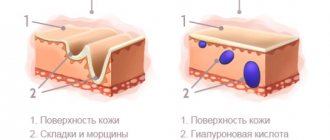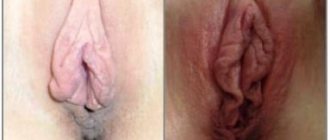Most women have never thought about the healthy size of their labia minora. And many gynecologists still do not pay any attention to this. In fact, in vain - after all, many gynecological pathologies arise due to hypertrophy of the labia minora.
Enlarged labia minora and clitoral folds are manifestations of an increased amount of male sex hormones in women, such a genetic predisposition. However, a blood test may not show an increase in testosterone. Women with enlarged labia may experience very painful periods, hormonal deficiency in a male child, and cystic changes in the ovaries. With the surgical reduction of hypertrophied tissue, a natural correction of hormonal levels occurs, the risk of precancerous conditions decreases, painful menstruation goes away, and pregnancies become easier.
Why are the labia minora needed?
The labia minora (lat. labia minora pudendi) are a pair of thin folds of the mucous membrane, the base of which is located inside the labia majora, parallel to them. They immediately surround the entrance to the vagina and the external opening of the urethra, and their anterior commissure passes into the skin of the clitoral head - the foreskin of the clitoris. One of the functions of the urinary tract is to direct the stream of urine away from the genitals; they are an erogenous zone, cover the entrance to the vagina and protect the vagina from infection.
The labia are an intimate (hidden) part of the body. There are no generally accepted canons of beauty in this area, however, the sexual attractiveness of this area is of great importance to many women and their partners.
Back to contents
Types of contour plastic technology
Depending on the area of drug administration, there are:
- LABIOPlasty of the labia minora
: makes it possible to change the shape of the labia, correct their asymmetry, get rid of sagging, and revive erotic sensitivity. - PLASTY OF THE LAVA MAJOR
- allows you to give an aesthetic shape and tone to the labia majora by changing their shape and volume. - PERINEOPLASTY
- stricture of the vaginal lumen. With the help of filler, an orgasmic cuff is formed, which enhances the sensitivity and tone of the organ. As a result of the procedure, the number and duration of orgasms increases. - G-SPOT ENLARGEMENT
- injection of a filler into the erogenous zone on the front wall of the vagina to augment its size. Stimulation of the Grafenberg point increases sensory arousal. Its location is not always accessible during coitus. Contouring makes the area more accessible during sexual intercourse and reduces the volume of the vagina. - CLITOROPLASTY
- adding volume to the clitoral pocket with filler provides access to the sensitive area. Helps normalize the production of natural vaginal lubrication and increases the hydration of the area. - CORRECTION OF AGE REGRESSIVE TRANSFORMATIONS
: with age, the dermis of the GPG becomes thin, tissue drooping is observed. The pharynx and clitoris degrade in size. The elasticity of the vaginal walls decreases, their epithelium atrophies. The function of vaginal secretion is impaired. - INTIMATE BIOREVITALIZATION
- moisturizing the female intimate area. Hyaluronic acid restores water balance, which helps eliminate dryness, normalize the elasticity and tone of the walls of the vagina and its vestibule. - INTIMATE AREAS WHITENING
is a complex procedure consisting of two stages: whitening skin peeling and application of a special lightening cream.
Shapes of the labia minora
There is no generally accepted standard for the size of the labia minora! It is generally accepted that, in the supine position, the labia should be visible, but without pronounced protrusion beyond the labia majora. It is believed that the “normal length” of the PGM from base to edge, from an aesthetic point of view, is 4 cm.
The patients themselves consider the labia to be elongated if they protrude beyond the labia majora. But this condition is not a pathology, it is a development option. From a medical point of view, hypertrophy, elongation and asymmetry of the labia minora are distinguished.
MPG hypertrophy
With hypertrophy, there is thickening of the walls, increased folding and elongation. The labia minora are enlarged evenly and symmetrically throughout.
MPG elongation
Elongation is lengthening without thickening; more often there is a lengthening of the middle part of the labia minora. Elongation can be congenital or acquired.
Reasons for MPG elongation
- Heredity;
- Prematurity (the labia majora do not cover the labia minora);
- Age-related atrophic changes;
- Traumatization (childbirth, horse riding, cycling, masturbation);
- Constitutional features (asthenic body type).
PGM asymmetry
Asymmetry of the labia minora can be congenital or acquired (trauma during childbirth, inflammatory changes, errors during plastic surgery). Asymmetry is considered to be both asymmetrical lengthening or shortening, as well as normal development of one labia and lengthening or underdevelopment of the opposite one. Asymmetry includes various types of post-traumatic deformities.
Traumatic deformity with the formation of a defect in the right lip
Back to contents
About indications for labiaplasty
The operation is performed on women, both for medical reasons and according to the patient’s personal desire to restore the beauty of the intimate area or improve the quality of sexual relationships.
Medical indications
Medical indications include situations when a woman complains of physical discomfort:
- Congenital or acquired deformations of the labia that disrupt their normal physiology;
- Traumatization by underwear;
- Frequent inflammatory phenomena;
- Pain during sexual intercourse and playing sports;
- Difficulties with hygiene;
- Psychological complexes - “Locker room syndrome”.
Aesthetic indications
For aesthetic reasons, labiaplasty is performed when a woman is dissatisfied with the shape or size of her labia. The only indication for surgery may be a woman’s desire to correct the shape and size of the labia minora. For many women, increased MPG does not spoil life at all. Pathology can be considered only those cases when medical indications prevail.
Back to contents
Vagina reduction
The colporrhaphy operation takes about 1.5 hours. It consists of excision of a wedge-shaped or oval section of the mucous membrane, strengthening of the levator muscles and tightening of tissues to reduce volume.
“The purpose of the operation is to restore the normal volume of the vagina, eliminate prolapse of the walls and displacement of the pelvic organs. An important aspect of intimate aesthetic surgery is returning to a woman the joy of a full sexual life.”
Egorova Maria Vladimirovna plastic surgeon
When indicated, the pelvic floor muscles are fixed with a special mesh. After its installation, the doctor sutures the submucosa and mucous membrane of the vagina.
Important! The mesh is acceptable only when the woman no longer plans to give birth, that is, after 40–45 years. The suture material does not need to be removed; it dissolves on its own.
Contraindications to intimate plastic surgery
Labiaplasty is not recommended for women who have not given birth and those planning a vaginal birth. During childbirth, there is a high probability of injury - ruptures in the area of postoperative scars, and repeated plastic surgeries are complex and the expected effect is difficult to predict.
- Oncological diseases;
- Mental illnesses;
- Diabetes;
- Decompensated chronic diseases of internal organs;
- Acute infectious diseases;
- Hemorrhagic disorders and treatment with anticoagulants;
- Acute inflammatory diseases of the female genital organs;
- Minor age.
Since labiaplasty in the vast majority of cases is performed for aesthetic reasons, absolute contraindications to its implementation are conditions, diseases and genetic factors that prevent a positive result:
- Genetic predisposition to the formation of rough colloidal scars;
- Collagenoses are immunopathological processes characterized by systemic disorganization of connective tissue (Marfan syndrome, lupus erythematosus, scleroderma, rheumatism).
Back to contents
Methods for correcting the shape and size of the labia
The method of plastic correction for each specific case is determined during a consultative examination.
Marginal resection (amputation)
The most commonly used method is to remove the edge of the MG. This method is the least natural from an anatomical point of view. In essence, amputation of the labia minora is carried out over a significant extent. The anatomical, most elastic edge, in which the sensitive nerve endings are concentrated, is removed. Subsequently, this can adversely affect sexual sensations and disrupt the natural barrier between the vagina and the external environment.
Scheme
Photos before and after
Wedge resection (plasty)
The method comes from plastic surgery and involves removing excess mass by cutting out tissue in the shape of a triangle and then suturing the defect. The technique allows you to preserve the edges and normal anatomy of the MPG, and, accordingly, get rid of the disadvantages of resection.
Scheme
Photos before and after
With hypertrophy, a larger volume of tissue is removed and two triangles are cut out.
Scheme
Photos before and after
Back to contents
Examination and preparation before labiaplasty
At the first visit, the surgeon finds out whether there are indications for plastic surgery, whether there are associated problems in this area and contraindications, the complaints and especially the patient’s wishes regarding the size and shape of the labia are clarified in detail. Patients are advised to formulate their wishes in advance, since most are embarrassed to tell what worries them and how they imagine the result of the correction; many are lost when asked simple questions and have difficulty finding words.
In order to evaluate the results of treatment, before and after surgery, photographs of the labia are taken in standing and lying positions on the back (front and back) with legs slightly apart.
After getting acquainted with the problem, an examination is performed on a gynecological chair, during which the correction method is determined. An informed consent for surgical intervention is signed and a preoperative examination is prescribed.
Examination before intimate plastic surgery and expiration dates of tests
Valid for 6 months:
- Fluorography.
Valid for 3 months:
- Blood test for HIV (AIDS);
- Blood test for RW (syphilis);
- Blood test for hepatitis B and C viruses;
- Ultrasound of the pelvic organs;
- Cervical smear for oncocytology.
Valid for 1 month:
- Blood group and Rh factor.
- Clinical blood tests;
- General urine analysis;
- Biochemical blood tests (sugar);
- ECG with consultation with a therapist.
Valid for 10 days:
- A smear to determine the degree of vaginal cleanliness (if infections and inflammation are detected, treatment is indicated).
Based on the results of the preoperative examination, a second consultation is carried out, the date of the operation and preoperative preparation are set.
Preparation for labiaplasty
- Stop sexual intercourse two days before surgery.
- The day before the procedure, cut or shave the pubic hair, labia and perineum short.
- On the eve of the intervention, go to bed no later than 22:00. You can take a sedative: tinctures of motherwort, peony, valerian, etc., according to the instructions included with the medications.
- In the morning, on the day of surgery, empty your bowels, take a shower and thoroughly clean the external genitalia, and put on clean knitted underwear.
- Hunger – last meal three hours before surgery.
- Immediately before the procedure, empty your bladder.
- HAVE WITH YOU:
- Referral for surgery, examination results (ultrasound and tests).
- A clean shirt (robe) and socks, sanitary pads, slippers. Leave jewelry (earrings, rings, etc.) at home.
Back to contents
Features of the functioning of the vagina and types of colporrhaphy
The vagina is a tube with 4 walls: anterior, posterior, and lateral.
The most mobile is the back one. When it descends, the rectum begins to “pull out” from the pelvic cavity (rectocele). This can lead to constipation and the formation of fecal stones. Even if the prolapse is slight, intoxication of the body, anal fissures and hemorrhoids may occur. Shortening the posterior arch and strengthening it by tightening the perineal muscles is posterior colporrhaphy. The side walls descend only when the uterus prolapses. This occurs during menopause. Here, an operation is needed to strengthen the side walls using dense implants made of non-absorbable materials - medium colporrhaphy.
When the anterior fornix subsides, the functioning of the urinary system changes. The posterior wall of the bladder is pulled up following the vaginal vault (cystocele), resulting in stagnation of urine. When the bladder is not completely emptied, an ascending infection of the kidneys occurs. Stretching the walls of the bladder entails atrophy of the receptors. This manifests itself as urinary incontinence, first only with coughing and laughter, and then with any tension in the abdominal wall. In this case, anterior colporrhaphy is used. During this procedure, the anatomical structure of the bladder is often restored - the sphincter is strengthened and the urethra is reconstructed.
You also need an examination by a gynecologist and a therapist.
Complications of labiaplasty
The anatomical norm and physiological function require that the labia minora cover the entrance to the vagina and the external opening of the urethra. Excessive resection causes disruption of anatomy and physiological function. This, in turn, leads to negative consequences - chronic inflammation of the vaginal opening and pain during intimacy, up to refusal of sexual activity. Changing the natural appearance of the external genitalia causes psycho-emotional discomfort in both the woman and her partner.
Gaping of the vaginal opening as a result of excessive resection
Back to contents
Efficiency and advantages of intimate area plastic surgery with hyaluronic acid
The use of fillers is an innovative replacement for surgical plastic surgery. This tactic allows you to quickly restore the impaired functions and aesthetics of a delicate area of the body, and get better emotions during sexual intercourse. The effect after the session will last from 6 months to one year. If desired, injections to increase libido can be carried out systematically.
Advantages of the technique:
- does not require general anesthesia and hospitalization;
- the components of the drug are safe and biocompatible;
- fillers have a prolonged effect;
- painlessness of the procedure;
- the gel does not migrate and does not cause organ deformation;
- You can repeat the procedure as the effect decreases.
Fillers based on hyaluronic acid activate the production of your own collagen fibers, as a result of which a natural framework is formed in the tissues of the intimate area, increasing their elasticity and density. Due to this effect, the need for preventive injections will gradually disappear.
Postoperative period and recommendations
To prevent early complications, immediately after surgery, bed rest is prescribed for 3–6 hours. After 3-6 hours, after examining the stitches, the doctor sends the patient home with the following instructions:
- Take prescribed medications;
- Appear for examination 7-8 days after surgery;
- Avoid sexual intercourse, baths, saunas, and physical activity for 6 weeks;
- Perform hygienic toileting twice a day;
- If you have any complaints, consult a doctor immediately.
Final healing of the labia minora is completed after 8-10 weeks.
At this time, the final result of labiaplasty can be assessed. All articles for Patients











